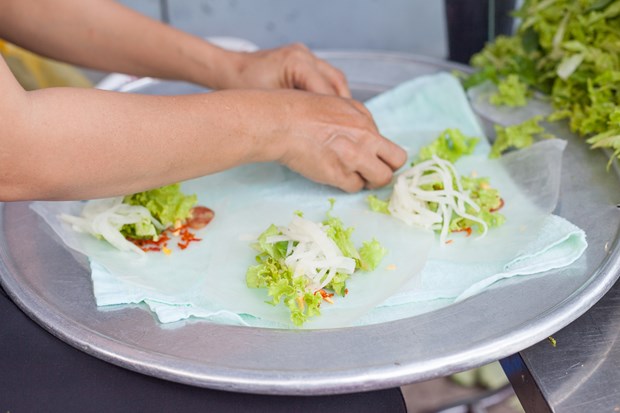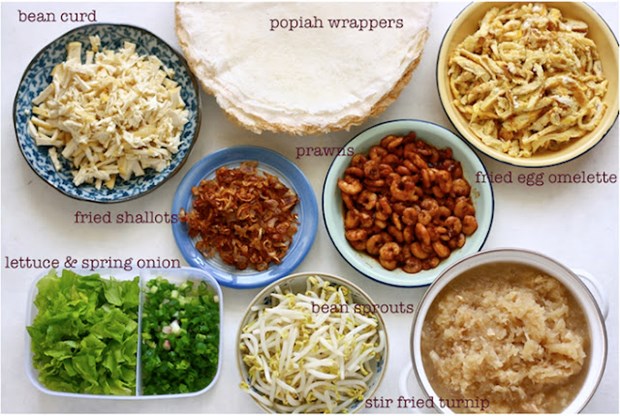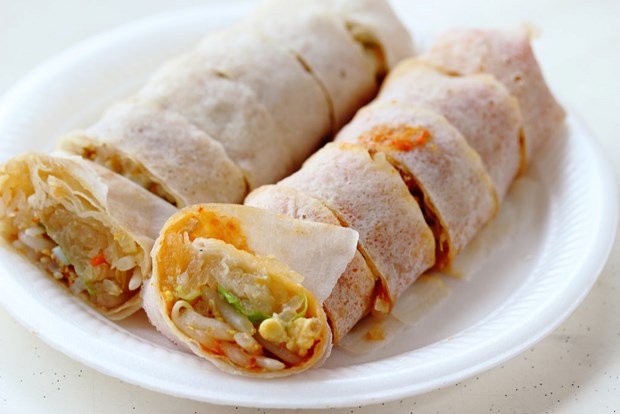Historically Saigon has been a busy trading hub that attracts merchants from all over the region, and the city's culinary repertoire is a smorgasbord of eclectic cultural influences.
In
the latest installment of our Food History series, we takes a closer
look at the history of a refreshing street treat that’s both delicious and
healthy: bò bía.
My
favorite memories of the dish, having been brought up in Saigon, almost always
involve sitting on a sidewalk shooting the breeze with friends over dozens of bò bía and a chilly glass of sugar cane
juice. Of all of the items that Vietnam has to offer, the humble roll must be
the closest to the true definition of “street food” – a quick, extremely
affordable snack that’s eaten on the street sans embellishments.
Have
I mentioned that bò bía is also
probably the cheapest food option around? Currently, most bò bía carts have adjusted their price according to the city’s
rising cost of living: VND2,500 - 3,000 per roll. It’s a shame, because I still
fondly remember a time when VND10,000 could get you a heaping packet of 20
rolls. I’m unfortunately not old enough to have lived in the golden era when a
roll of bò bía cost VND200. My
mother, however, swears by an old stall that once was near the entrance of
Saigon’s Pedagogy University where she undertook her undergrad program. Fine
mom, you win.
The
anatomy of a bò bía roll starts with
the core ingredients: jicama, or củ sắn,
and rice paper. The starchy root vegetable is julienned into thin strips and
blanched until soft to the touch. As the only hot ingredient of the filling,
the boiled jicama is always kept warm in a pot at all bò bía carts.

Photos by Brandon Coleman.
Other
toppings may vary depending on the locality and personal taste of the cook, but
most feature slices of lạp xưởng,
omelette and dried red krills, or ruốc,
for proteins; and lettuce and fresh herbs as the vegetable components. It’s
simple, but packs a punch of flavors and is actually low-carb. Saigon street
food was low-carb before it was cool, go figure.
Tracking
the origin of bò bía in Saigon is
both a simple and complex task, for different reasons. On one hand, its birth
place is obvious: the vegetable roll made its way to old Saigon along with
Hokkien and Teochew immigrants from China. This trend was not limited to
Vietnam, as Singaporean and Malaysian popiah (薄皮卷) is also a part of those nations’ Hokkien heritage.
Our neighbors, however, have mostly managed to keep their rendition of bò bía faithful to the original, unlike
Vietnam’s.

Popiah ingredients. Photo via Recipe Great.
Traditional
bò bía and Singapore’s popiah rolls,
for example, use a thin sheet of dough as the wrap, while ours stay local with
a quarter of a big sheet of bánh tráng.
Popiahs feature more fillings and are accompanied by a different dipping sauce
that’s less earthy and has more umami. Therefore, popiah stalls usually cut up
their rolls into bite-size morsels like sushi to make them easier to eat.

Photo via SG Food on Foot.
However,
Saigon's been through a lot of changes, so much so that finding a true-blue
Hokkien or Teochew vendor that sells the dish is a daunting task. Most stalls
these days are manned by Saigoneers who find the roll a convenient and easy
option with which to start a business.
Saigon’s
popiah, however, are tiny and can be finished in two bites – or one if you’re a
glutton like me. Two dips in a small bowl of bean paste with fried shallots,
chili and crushed peanuts; and voila, you just finished a bò bía.
As
far as Vietnam’s street food goes, there are more filling, more complex and more
scrumptious dishes than bò bía, but
at the end of the day, a roll isn’t meant to be the aforementioned things: it’s
simply fuel for some good times with friends while catching up after a long
day, because nothing strengthens friendship like eating delicious food on the
pavement while watching out for Doan Ngoc Hai’s sidewalk crusade.
By Saigoneer